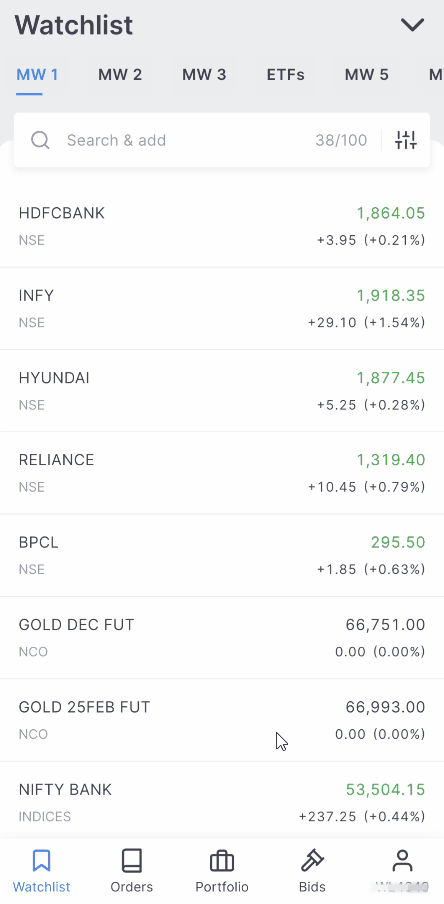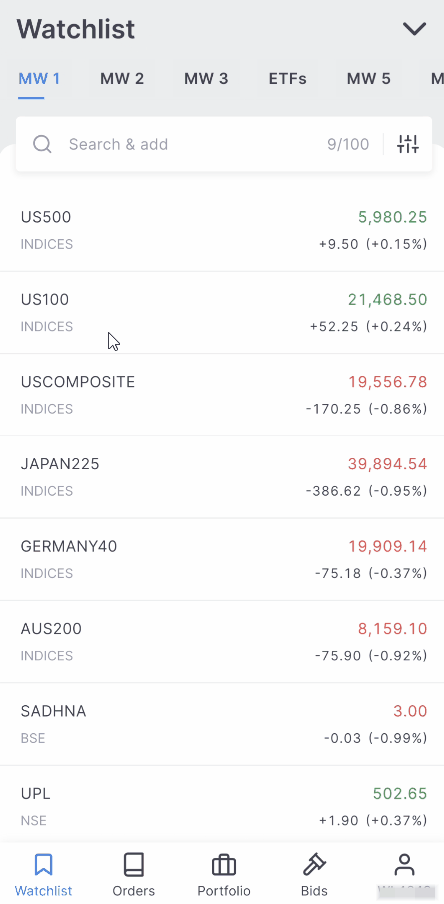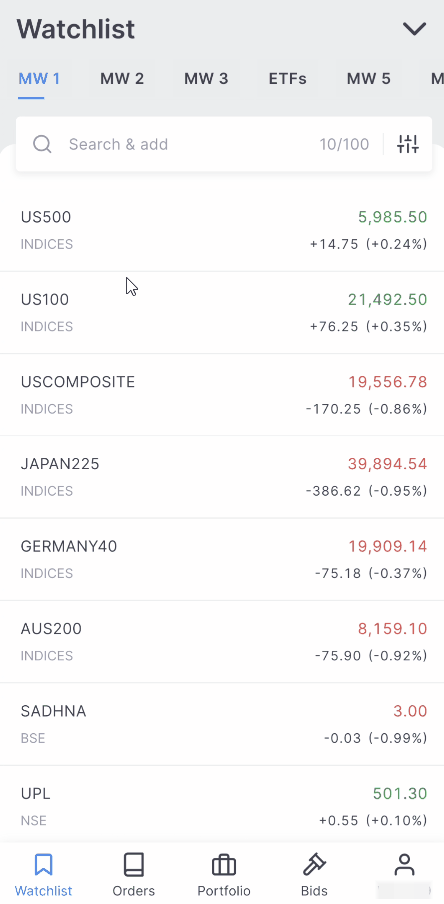Marketwatch¶
- The Marketwatch includes seven watchlists numbered from 1 to 7.
- Each watchlist can display a maximum of 100 instruments.
- Users can swipe left or right to switch between watchlists or long press to manually arrange the instruments.
- Users can rename watchlists by long-pressing on them, entering a new name, and tapping Save. Delete instruments by tapping on the bin icon.
- Shares on the watchlists are denoted by a briefcase icon that indicates the number of holdings.
- Instruments can be sorted alphabetically based on the percentage change or the Last Traded Price (LTP) by tapping on the filter icon beside the search bar. Instruments can also be filtered by selecting the exchanges. To learn more, see How to save marketwatch settings in Kite?
- Open High Low Close (OHLC) data, average price, volume circuits, Last Traded Time (LTT), Last Traded Quantity (LTQ), Open Interest (OI), day’s range and contract expiry information for each instrument are displayed by clicking on a particular instrument on the marketwatch.

Pin instruments¶
Instruments can be pinned globally for easy viewing. To pin instruments in the Overview, follow these steps:
- Tap on the instrument.
- Scroll down and select Spot 1 or Spot 2.

Pinned instruments appear only when the downward arrow icon is clicked. To display pinned instruments across all sections without needing to click the arrow, enable sticky pins in the settings. To enable sticky pins, follow these steps:
- Tap on user ID.
- Tap on Settings.
- Tap on Sticky pins.

This ensures that pinned instruments remain visible at the top of every screen.
Adding instruments¶
To search for any stock, index, ETF, F&O contract, mutual fund, IPO, or government securities, type the name of the instrument in the search bar on Kite. To add the instrument to the marketwatch, hover over the instrument and click on the + icon. Mutual funds, IPOs and Government securities cannot be added to the marketwatch.
Stocks and ETFs: To add stocks or ETFs, type in their name. For instance, to add Reliance, type Reliance and tap the + icon.
Index: To add Nifty indices such as Nifty 50, Banknifty or Nifty Financial Services type Index followed by the name of the index. To add Nifty Financial Services, type Index Nifty Fin Service and tap on +.
Futures contract: Search the trading symbol followed by a space and then the month followed by Fut. To add the September futures contract of Bank nifty, type BankNifty Sep Fut and tap on +.
Options contract: Search the trading symbol followed by a space and then the strike price followed by CE or PE. The strike price of the weekly and monthly options is displayed. To add the first week of September 17000 call option contract of Nifty, type Nifty 17000 CE and tap on +.

To search specifically for any mutual fund, IPO, or Government securities, click on MF, IPO, or G-Secs and type the name in the search bar. However, they cannot be added to the watchlist. When a user clicks on any mutual fund, they are directed to Coin. Clicking on IPO opens the IPO order placement window, while clicking on government securities will display the G-sec order placement window. To learn more about adding instruments to the marketwatch, see How to add instruments to the marketwatch?

Events¶
To search for stocks undergoing corporate actions, you can use the Events search feature on Kite:
- Tap on the search bar.
- Select Events.
- Search for a specific corporate action, such as dividends, bonuses, or quarterly results.
- Tap on + to add the stock to the marketwatch.

Brands¶
To search for stocks using brand names, product names or themes, you can use the Brands search feature:
- Tap on the search bar.
- Select Brands.
- Search for a brand, theme or product such as Milk.
- Tap on + to add the stock to the marketwatch.

Sort and filter¶
Tap on the Sort and Filter icon on the top right to sort or filter the marketwatch instruments. Save the order of the instruments after sorting by tapping on the Save icon.
